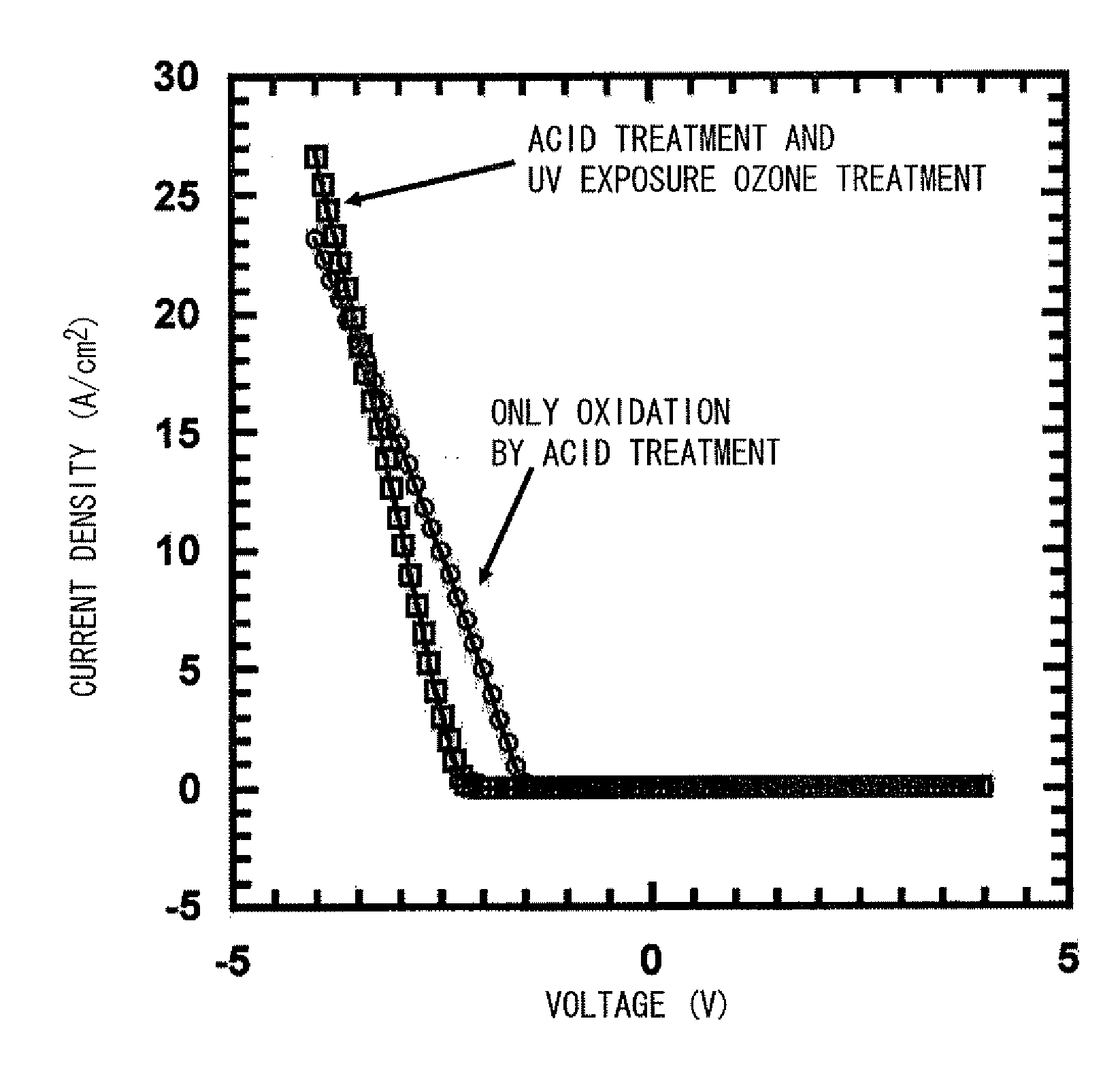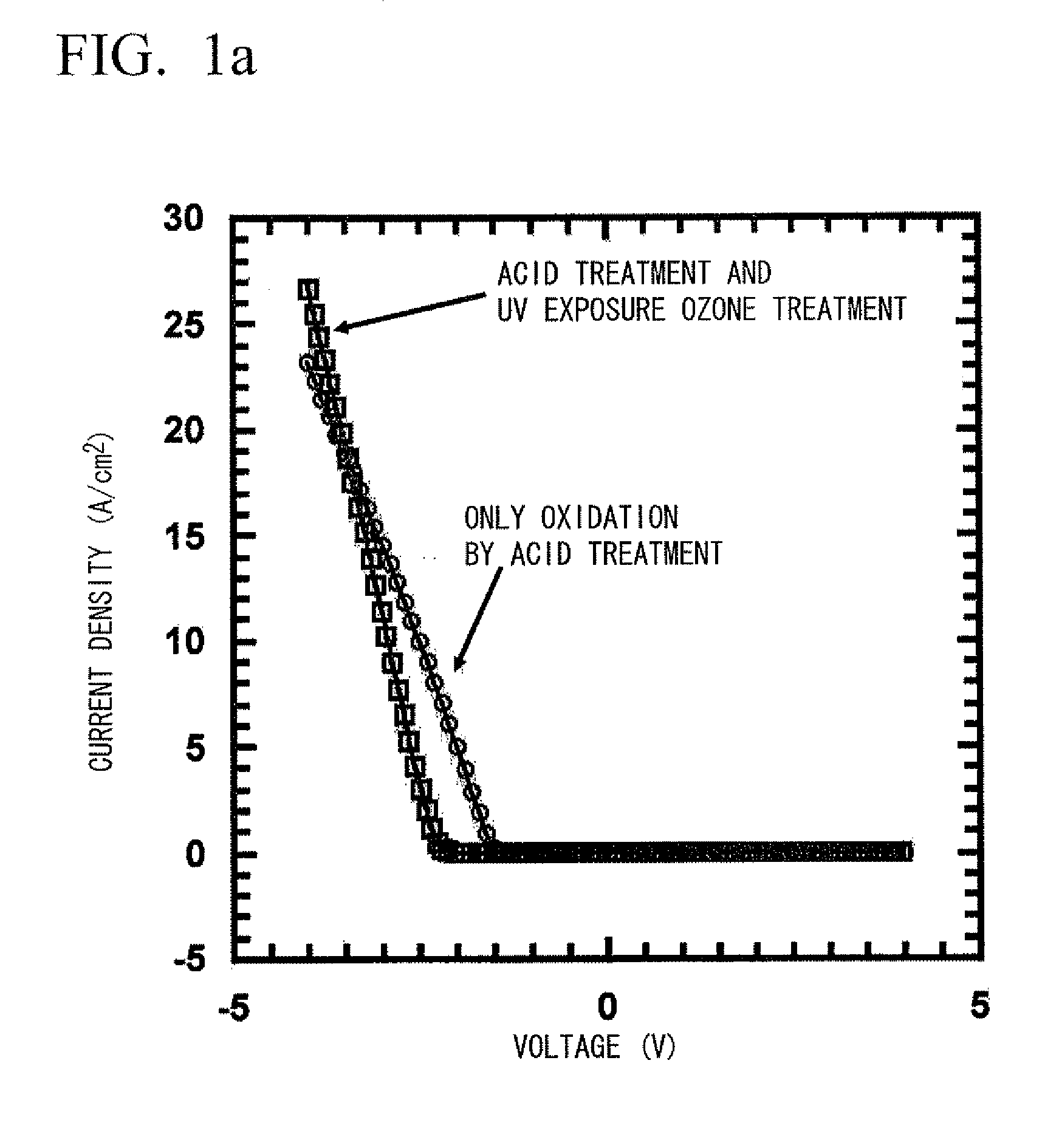Method for diamond surface treatment and device using diamond thin film
a technology of diamond surface treatment and thin film, which is applied in the direction of basic electric elements, electrical apparatus, and semiconductor devices, can solve the problems of insufficient thermal conductivity, difficult to control the height of schottky barrier, and dielectric breakdown voltage, etc., to achieve high reverse voltage, stabilize diode characteristics, and suppress reverse leakage current
- Summary
- Abstract
- Description
- Claims
- Application Information
AI Technical Summary
Benefits of technology
Problems solved by technology
Method used
Image
Examples
embodiment 1
Fabrication of Schottky Barrier Diode
[0051]A low-concentration boron-added homoepitaxial diamond thin film which was formed in a thickness of 1 μm on a high-concentration boron-added diamond single crystal at boron concentrations of 100 ppm to 10 ppm and 1 ppm or lower with respect to carbon inside a reaction tank for microwave CVD method was used as a specimen. The acceptor concentration was 1.5×1015 to 9×1016 / cm3. After cleaning of a substrate with hot mixed-acid of nitric acid and hydrochloric acid, a Ti / Pt / Au ohmic electrode was formed on the high-concentration boron-added diamond on the back of the substrate to conduct alloying annealing. Then, in an environment of an oxygen atmosphere of 50% oxygen and 50% nitrogen, the substrate was exposed to UV rays containing wavelengths of 172 nm or 184.9 nm, and 253.7 nm, and UV ray ozone concurrent treatment was conducted on the substrate at 500 ppm to 1000 ppm of ozone formed by UV rays in a ultraviolet ray intensity of 3.7 mW / cm2 for ...
embodiment 2
[0053](1) Quantification of Surface Oxygen Amount
[0054]A substrate subjected to UV ozone treatment was subjected to XPS (X-ray photoelectron spectroscopy) and the amount of oxygen atoms adsorbed on the surface was measured. The measurement found peaks of carbon, oxygen, and silicon. Evaluation was made for coverage by referring to the respective peak area ratios, measurement sensitivity coefficients and mean free path of C1s photoelectrons. FIG. 4 shows a ratio of O1s peak area to C1s peak area by various treatments.
[0055]It is noted that in this measuring apparatus, the ratio of O1s / C1s, or approximately 0.2 was equivalent to approximately 50% of an amount of oxygen adsorbed by the surface of the substrate. The measurement result revealed that in the oxidation treatment by the hot mixed-acid treatment, the ratio of O1s / C1s was from approximately 0.1 to 0.2, but the concentration of oxygen adsorbed on the surface was increased in accordance with an increase in UV ozone treatment tim...
embodiment 3
Example of Mo
[0057]FIG. 6a is a graph showing electric characteristics of devices which have Schottky electrodes including Mo and were subjected to a UV ozone treatment or an ozone treatment according to the present invention. The Schottky barrier height (SBH) was increased in accordance with an increase in the ozone treatment time. The SBH of the elements that had been subjected to ozone free treatment with the use of Mo was 1 to 1.2eV. Where the elements were subjected to the ozone treatment for 3 and 6 hours, the respective SBHs were 1.2eV and 1.4eV. However, when the elements were subjected to the UV ozone treatment, a higher SBH of 2.5eV was observed.
[0058]FIG. 6b shows the reverse characteristics of the elements which were subjected to the ozone treatment for 3 and 6 hours and to the UV ozone treatment. Elements higher in SBH were effectively decreased in leakage current even at a high voltage. Therefore, the elements that were subjected to the UV ozone treatment had a lower l...
PUM
| Property | Measurement | Unit |
|---|---|---|
| reverse leakage current | aaaaa | aaaaa |
| wavelengths | aaaaa | aaaaa |
| wavelengths | aaaaa | aaaaa |
Abstract
Description
Claims
Application Information
 Login to View More
Login to View More - R&D
- Intellectual Property
- Life Sciences
- Materials
- Tech Scout
- Unparalleled Data Quality
- Higher Quality Content
- 60% Fewer Hallucinations
Browse by: Latest US Patents, China's latest patents, Technical Efficacy Thesaurus, Application Domain, Technology Topic, Popular Technical Reports.
© 2025 PatSnap. All rights reserved.Legal|Privacy policy|Modern Slavery Act Transparency Statement|Sitemap|About US| Contact US: help@patsnap.com



